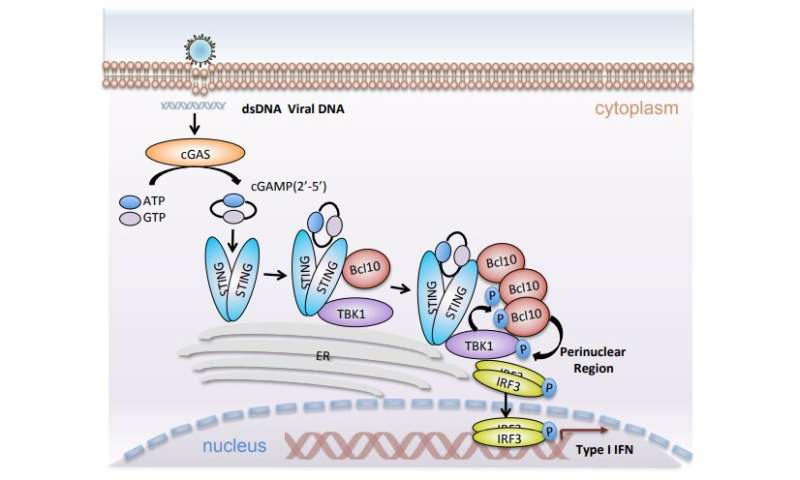Bcl10 phosphorylation-dependent droplet-like condensation positively regulates DNA virus-induced innate immune signaling

A study led by Dr. Xin Lin (Institute for Immunology of Tsinghua University) found that the upstream regulator of NF-κB, B-cell lymphoma 10 (Bcl10), is involved in regulating the natural immune response induced by DNA viruses.
Innate immune responses constitute the first line of defense against viral infections. Upon viral infections, the host recognizes the pathogen-associated molecular patterns (PAMPs) through pathogen-recognition receptors (PRR) to initiate the antiviral response. This activation induces antiviral proteins and cytokines, which contribute to the elimination of infected viral pathogens.
Upon DNA virus discovery or cytosolic DNA stimulation, STING undergoes conformational changes. STING with conformational changes then releases the carboxy-terminal tail to recruit and activate TBK1, which consequently phosphorylates STING. The phosphorylated STING binds to the positively charged surface of IRF3 and recruits IRF3 to be phosphorylated by TBK1. Once IRF3 is phosphorylated, it forms a homodimer and translocates to the nucleus to induce the expression of type I IFNs. However, the mechanism by which TBK1 is activated in this antiviral signaling cascade remains unclear.
In this study, the authors find that Bcl10 deficiency results in an impaired anti-virus response following HSV-1 infection. The activated STING links Bcl10 to TBK1 to induce Bcl10 phosphorylation by TBK1 after DNA virus infection. Then the phosphorylated Bcl10 forms droplet-like condensation and activates Bcl10. The activated Bcl10 induces a feedback enhancement on TBK1 phosphorylation, and further positively regulates IRF3 activation and promotes the expression of type I interferons. Therefore, this study reveals a molecular mechanism by which Bcl10 and TBK1 form a positive feedback loop downstream of the cGAS-STING pathway to induce innate immune response. This work further elucidates mechanisms of antiviral innate immunity, provides possible explanations of pathogenic mechanism, and offers new ideas for treatments of immune-related diseases caused by pathogen infection.
See the article:
link.springer.com/article/10.1 … 07/s11427-022-2169-x
More information:
Dandan Yang et al, Bcl10 phosphorylation-dependent droplet-like condensation positively regulates DNA virus-induced innate immune signaling, Science China Life Sciences (2022). DOI: 10.1007/s11427-022-2169-x
Provided by Science China Press